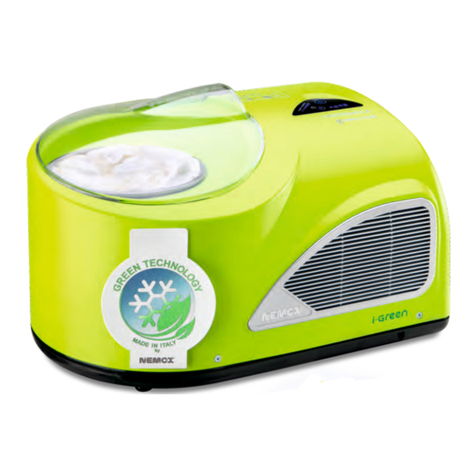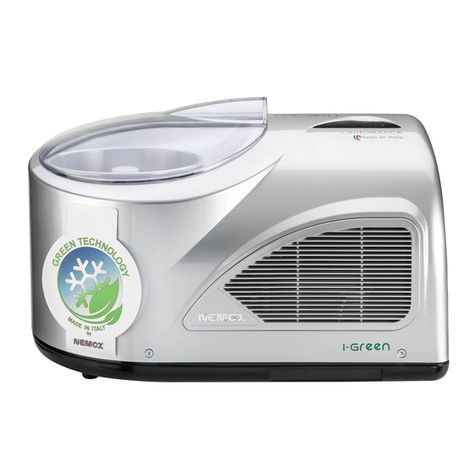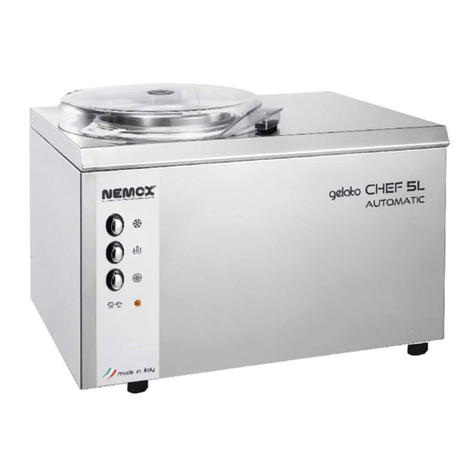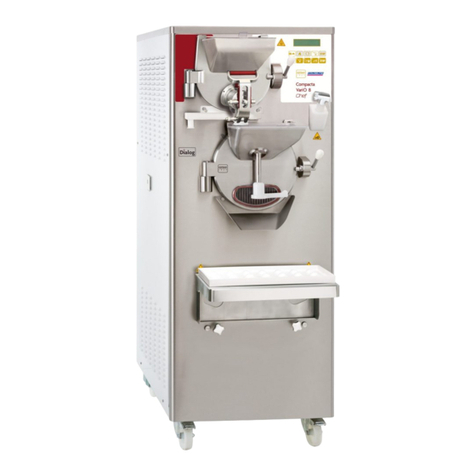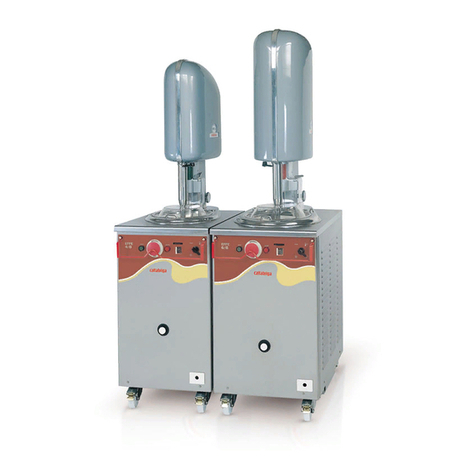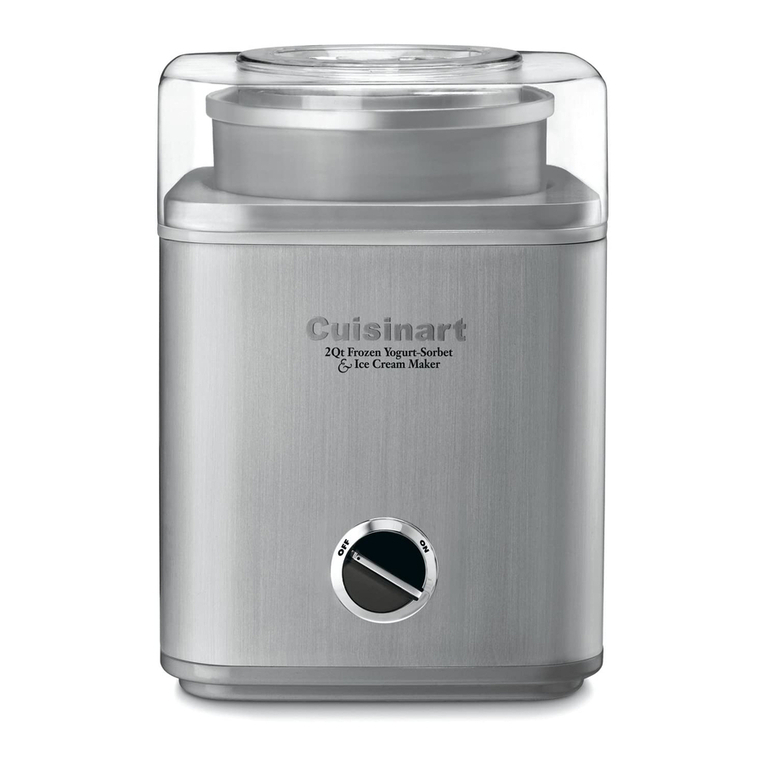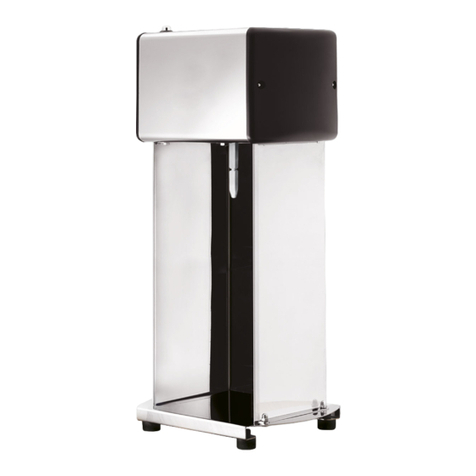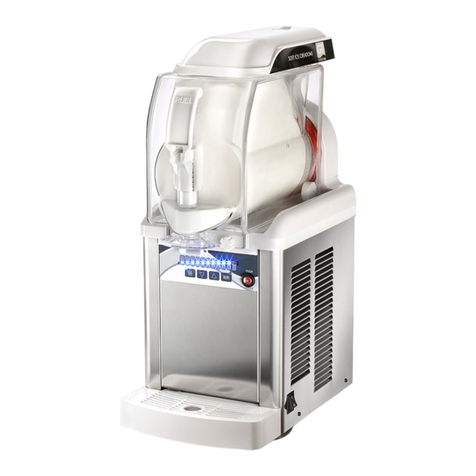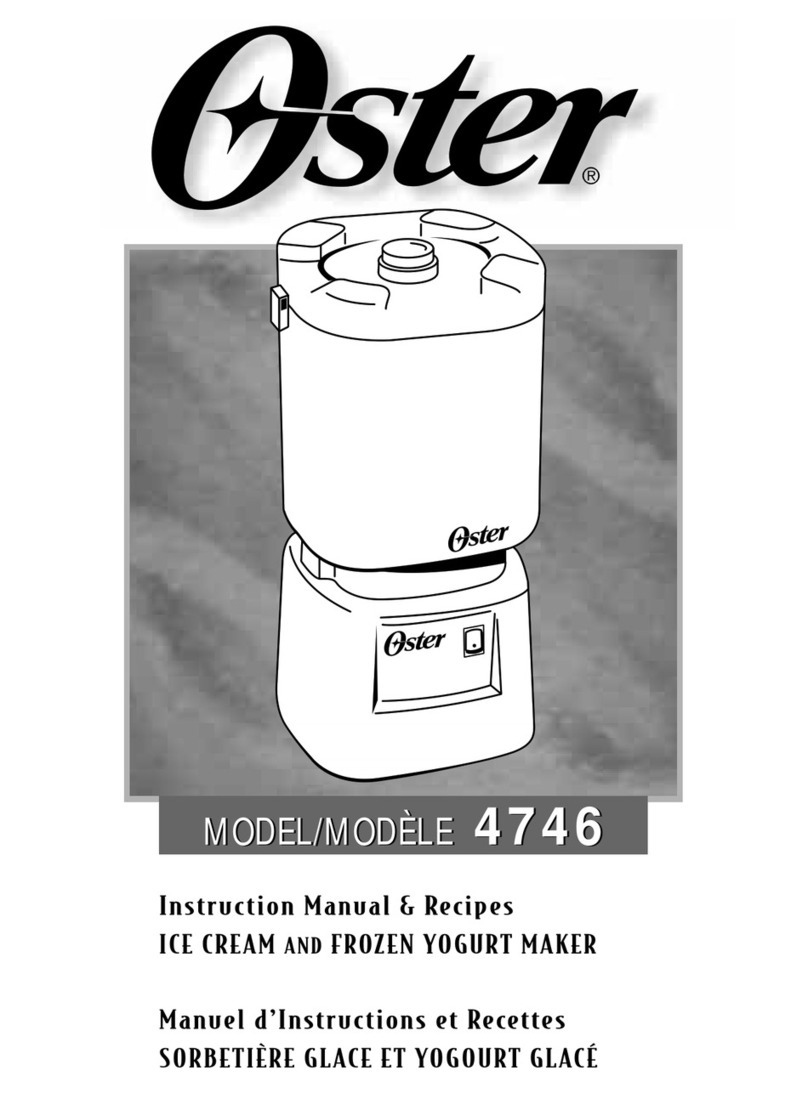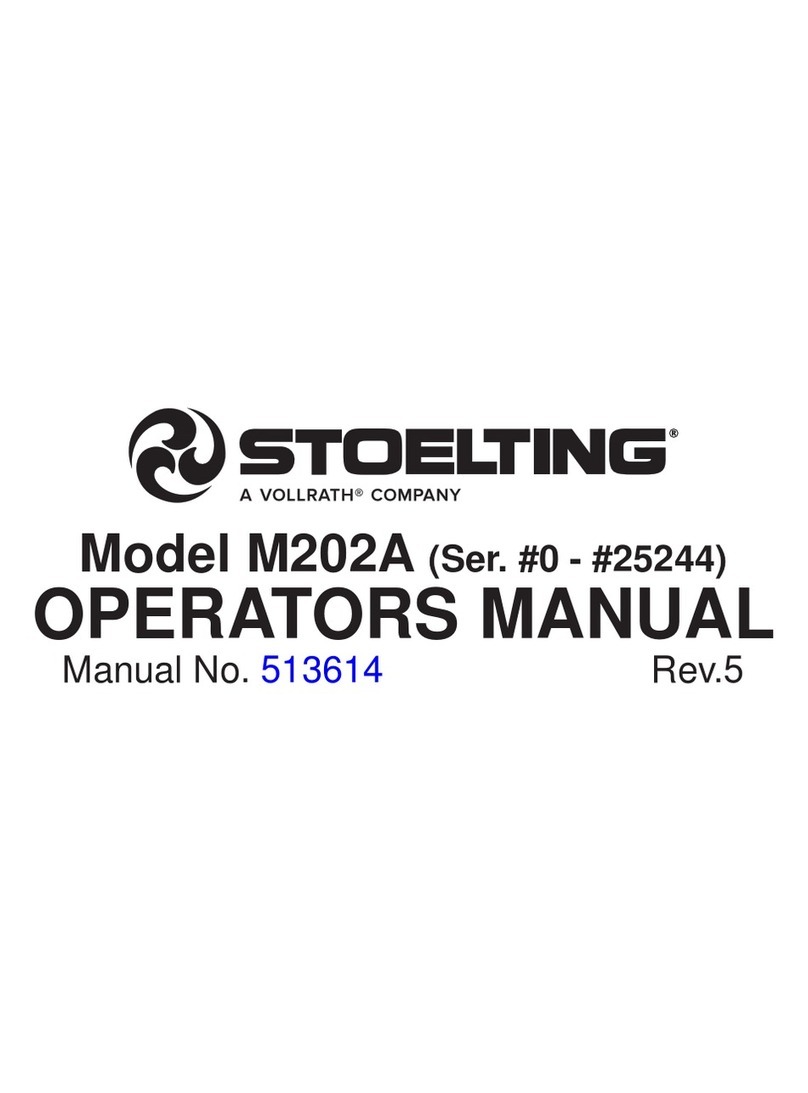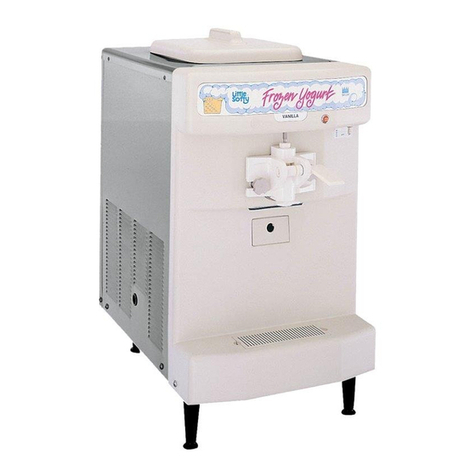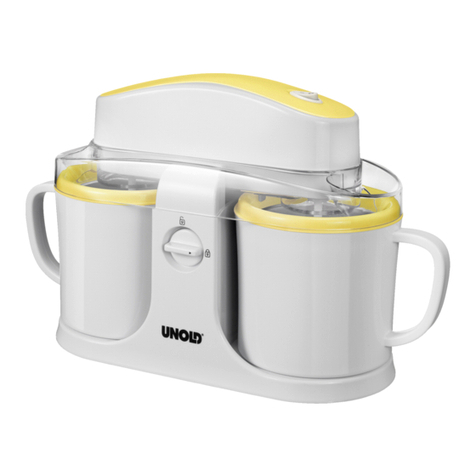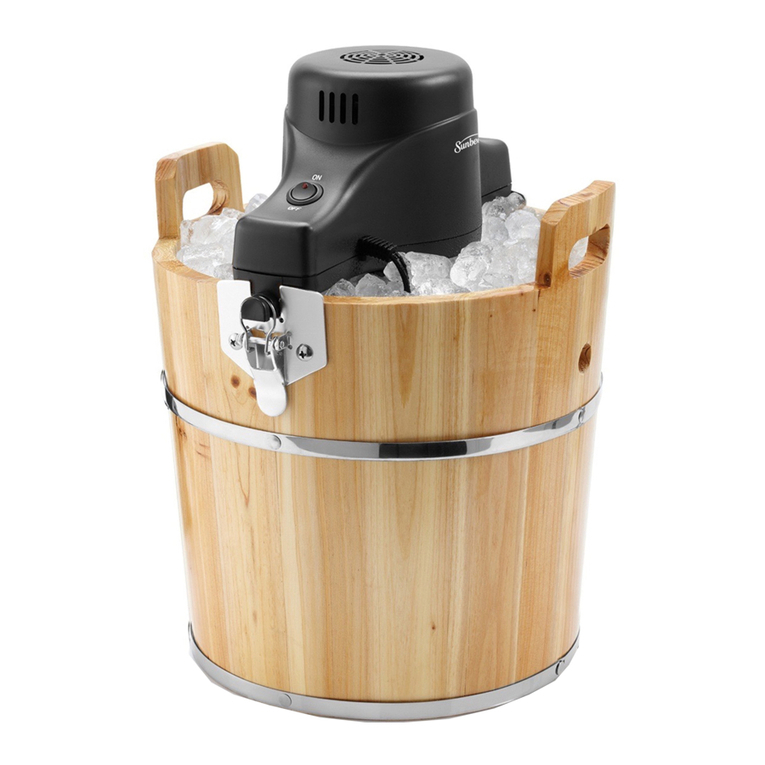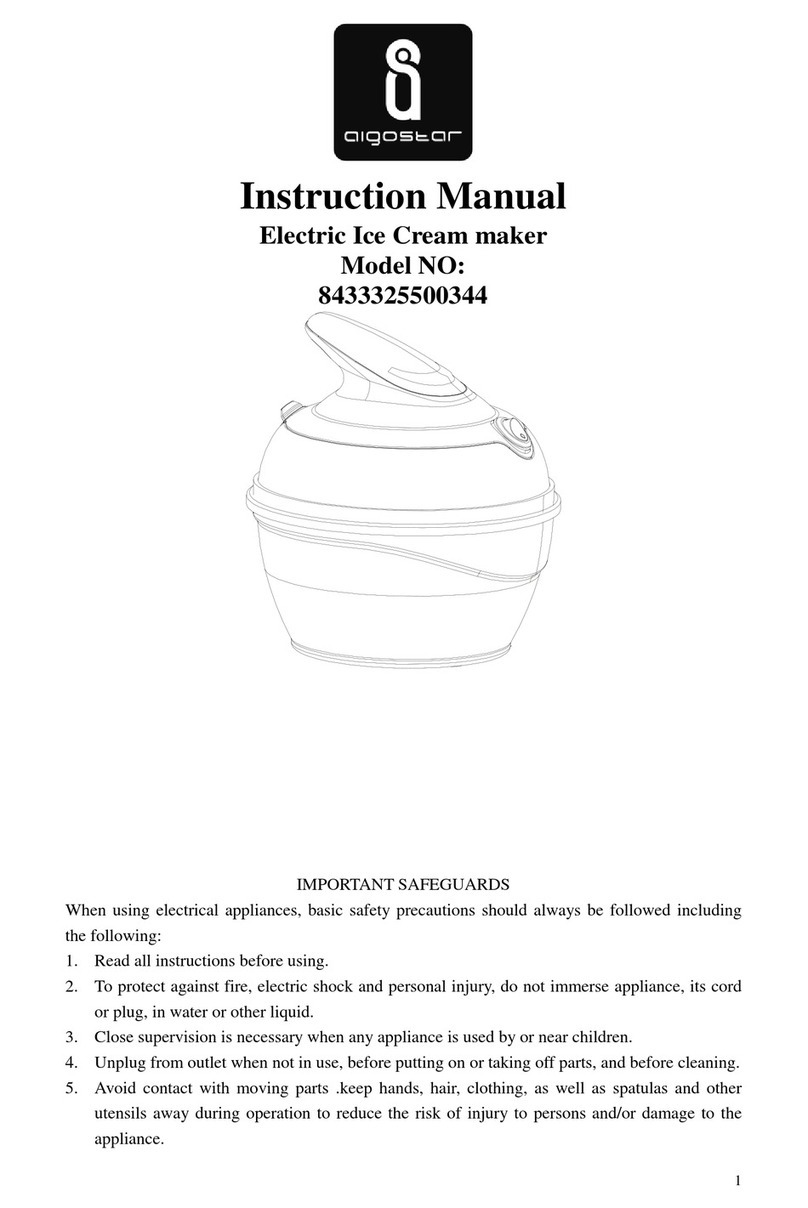
English
10 11
English
gradually.
•Once you have selected the desired cycle,
the corresponding LED will flash for 3
seconds and will become steadily lit,
enabling the selection.
•If you operate the knob that adjusts the
paddle speed, you will be able to adjust the
density of the preparation: to low speed
corresponds a higher density while at high
speed you will have an increased air intake
and a smaller density of the preparation. The
speed and selected cycle combination
makes it possible to obtain various
preservation cycles in all possible
conditions.
VARIATION OF THE PRESERVATION CYCLE
You can always select a different preservation
cycle either during the active phase and
during the pause phase of the running cycle.
Repeatedly press button (12) until the LED
that corresponds to the desired cycle is
activated. The LED will flash for 3 seconds
and become steadily lit: The new preservation
cycle is now selected and it will be run for the
set execution times.
Should it become necessary to switch to a
preservation cycle associated to a different
program, you must enable the corresponding
program priorly, by pressing the button (11).
Once you have enabled the program, switch
to the preservation cycle by pressing buttons
(2) and (1) simultaneously for 3 seconds. The
machine will enable the preservation cycles
associated to the preset program.
SWITCHING FROM PRESERVATION PHASE
TO A PRODUCTION PROGRAM
With the preservation active, you can activate
an automatic program simply by selecting it
by pr ess in g bu tt on ( 11 ). T he L ED
corresponding to the selected program will
flash for 3 seconds and become steadily lit;
the machine will exit the preservation cycle
and run the selected program.
Subsequently, the preservation cycles
associated to the selected program ill be
enabled.
PADDLE LOCK UPON LID OPENING
The opening of the lid (3) only stops the
paddle (5) and does not affect the
preservation cycle.
The closure of the lid (3) enables the paddle
operation (5) (on the condition that it is
provided by the selected preservation cycle in
that moment). If the mixture proves
excessively hard and prevents the movement
of the paddle, the machine will automatically
re-activate the preservation cycle from the
start.
TURNING OFF THE MACHINE DURING
PRESERVATION
To turn off the machine, hold down button (11)
for 3 seconds and then act on the main switch
(10). Do not act directly on the main switch
(10)!
IMPORTANT
•Each preservation cycle continues until the
user decides to stop it.
•The machine is not designed for use either
for storage or as a refrigerator! Store the
preparation in the pot for no longer than 12
hours.
•The cooling fan of the cooling system will
always remain in operation for the entire
duration of the preservation period.
•After use, ALWAYS turn the machine off
using the main switch (10).
TIPS
•U sin g ing r edi ent s at re fri g er a tor
temperature will reduce the processing
time. Furthermore, it is possible to reduce
the temperature of the ingredients if hot with
the appropriate fast cooling program.
•Be careful not to insert ingredients that are
too cold or nearly froze, as whipping may
have a poor quality.
•For a correct volume increase during mixing,
use maximum kg of ingredients2.2 for the
preparation of ice cream and sorbet.
•For the preparation of Granita, the maximum
amount of ingredients is 2Kg with the paddle
supplied with the machine.
It can process up to 2.7kg of Granita using
the special Granita paddle that can be
purchased separately.
CLEANING THE POT
GELATO 15K CREA is designed to facilitate
pot cleaning. Proceed as follows:
•Turn off the cooling system, remove the
paddle and pour at least 2 litres of hot water
and a low-foaming detergent into the pot.
•Wash the pot with a sponge. Do not use
sharp utensils inside the pot.
•Place an empty container of at least 3 litres
under the drain (7).
•Remove the plug (9). The water in the pot
begins to flow into the container below.
•Repeat the operation using hot, clean water
and rinse thoroughly.
•When the pot is empty, clean the discharge
pipe using the cleaner (22) previously
cleaned.
•Clean the plug (9). Reposition the plug (9)
until the pot discharge is fully closed.
•Repeat the cycle until the pot is completely
cleaned.
•Dry with a disposable paper towel.
•Proceed with the cleaning of the rest of the
machine.
MAINTENANCE AND CLEANING OF THE
MACHINE
•Before cleaning the machine, make sure that
it is turned off (main switch (10) to OFF) and
unplugged from the power plug.
•Remove the paddle scrapers (18), (19) and
(21) by pulling outwards.
•Remove the steel pin and remove the
transparent lid (3) from the machine.
•The paddle (5), the paddle inserts (18), (19)
and (21), the transparent lid (3), the
transparent lid cap (3a), the silicon cap, the
plug (9) and locking ring (4) can be washed
in the dishwasher or in hot water with
suitable detergent.
•If the paddle inserts are damaged or worn
out, they must be replaced to prevent mixing
ingredients less effectively.
•Clean the body of the machine and the non-
removable parts with the specific product
given in SANITIZING chapter.
IMPORTANT: do not wash the machine with
jets of water! It contains electrical parts.
•Clean the ventilation grids (6) also on the
rear part of the machine at least once a year.
•Regularly (at least once every 3 months)
check the oil seal (13) on top of the
transmission shaft: if necessary replace or
lubricate with H1 category grease or higher.
A specially designed grease can be
purchased at any Authorized Service
Centre. An oil seal replacement (13) is
supplied with the machine.
•Regulary lubricate the gaskets of the plug
(9).
•Proceed with the sanitization (see the
SANITIZATION chapter) in order to avoid
any bacteria growth at least one time in a
week.
SANITIZATION
Sanitizing operations, if properly carried out,
allow for the removal of a significant
proportion of micro-organisms whose cells
and spores find, thanks to processing
residues, favourable conditions for survival
and proliferation. Must be carried out at the
end of daily production cycle or more often, if
necessary.
WARNING: standby mode should not be
used in lieu of proper cleaning and
sanitization procedures at the frequencies
required by the federal, state, or local
regulatory agency.
Sanitizing involves two phases:
• Remove dirt (coarse residues) CLEANSING
and rinse with lukewarm water immediately
after work; cleaning action is provided by
manual friction and water pressure. The use
of a chemical detergent reduces, but does
not cancel, the manual cleaning requested
above. cleansing only, even if CAUTION:
accurate, does not ensure complete
removal of micro-biotic contaminants.
Proceed as follows:
•Leave out the paddle (5) and the nut (4)
from the pot, remove the lid (3) from the
machine.
•Rinse the pot with water hotter than 45°C
first, to dissolve grease and facilitate its
removal, but below 60°C to avoid
"cooking" proteins, sugar or fat and make
them stick even firmly to the surfaces
subjected to cleaning.
•Remove the coarse dirt mechanically from
